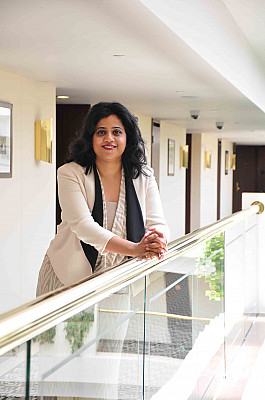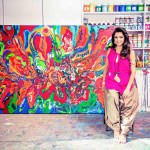Under The Hammer!
As Vice President, Head of Sales, Modern & Contemporary South Asian Art of Sotheby’s in New York, you would be absolutely right to reckon Priyanka Mathew’s regular day to be anything but typical. One evening you may find her curating an art show, readying it for an auction, and the next morning you may spot her getting on a flight to North America to estimate a painting’s worth. “It’s different every day. You just never know what to expect, and that’s one of the things I like about my job.”
Being an avid traveller, it would have been hard for her to say no to such a nomadic job-type. Then again, as much as she enjoys the artistic sights, she also yearns for days when she can take off to just be a usual tourist – indulging in sightseeing, food and idly taking in the culture.
Today, her life is a paradoxical juxtaposition of many things. As an auctioneer, and a sales person, she needs to be social; but if you catch her at a party on her own time, it would be a rarity in entirety. “Sundays are my days off and that’s when I’m a recluse.” Come day end, and her body shrugs off the high heels and jackets, and readies itself in loose kurtas for some modest gastronomy feats, and a curling-up with a riveting book.
Yet, when the investment banker (first at Lehman Brothers and then at Goldman Sachs) was crunching numbers behind a desk during the day, her nights were about her practising for her theatre production. After college, this economics-theatre major and her friends started a theatre company called ‘Alter Ego’. “Basically we were a bunch of lawyers and bankers who would have liked to have some creative expression outlet.” Plays like Tom Stoppard’s Indian Ink is one of their fabrications, as well as many written by friends. “I’d always take my vacation time around when my theatre production would go up. I think that was an indication to me that helped me think about what I wanted to do later in life.”
Then one morning when she was out with a few friends watching a cricket match, a gallery owner happened to draw her into a little chat. They kept in touch after that and a few months later, she heard from him again. Very aware of her penchant for art, he wrote to her asking if she knew any suitable person to fill the position of their gallery’s director. “That sort of sparked the idea of maybe doing it for a year and then seeing where it went, because I’ve always liked the intellectual rigour of how art challenges you – whether it’s the theatre or fine arts; also at the time, I needed to find something I would enjoy and which didn’t feel like a job.”
Shortly after being a gallery director, Sotheby’s happened to Mathew. She is living a life she looks forward to. Her colleagues and their humour help keep the atmosphere light and lively. Just when she thought she found herself where she wanted to be, her boss at the time recommended her to a senior auctioneer, Hugh Hildesley for training. “He had trained my boss too, and is sort of my auctioneering guru.”
A year later she was ready as the first Indian lady auctioneer in the history of Sotheby’s, and has since taken nearly 30 auctions, including charity events. In spite of it being a male dominated field, she never felt discriminated against. Perhaps seeing a woman on stage is an aesthetically pleasant change to having men in suits woo the audience for a sale?
Her relationship with this stage though, is slightly different. From performing for the audience, she now performs with the audience. She needs at least an hour to prepare herself for the auction. “Before I go on the rostrum (auctioneering podium), I shut my phone, stop communicating with everybody and I focus all my attention on the auction book. I go through the lots and see what the low estimates are for everything before deciding on each of my (introductory) piece to them is going to be. In my head, I play the rhythm of how the auction will feel like. Then I drink a glass of water, take a deep breath and set off!”
Once up there, the whole part of connecting with the people, reading them, coaxing them, keeping numbers, tracking bids, keeps her in spirit. Her first sale of a Gaitonde piece that went for 2.5 million dollars gave her a different kind of rush altogether. This negotiating banter actually takes her back to her investment banking days because the basic concept of buying and selling applies here as well. In fact, it was her background in the trading business that attracted her employers’ to her in the first place. “Being in this field, I enjoy the left-brain, right-brain dynamics. I also enjoy the creative aspect, as much as the economics of how the art market works.” Maybe it stems from her upbringing – being dragged to Delhi’s galleries as a child by her artistic mum, as well as influences from an academically inclined father.
Having grown up with an exposure to largely Indian artists, her home, surprisingly is filled with pieces from Pakistan. She loves their art to such an extent that she essays a trip to the country each year for more. Sana Arjumand, and Iftikhar Dadi from Pakistan, and Binoy Varghese and Pramit Roy from India are a few, apart from the Husain and Raza that layer her walls. No wonder South Asian art has come to become her speciality.
Art is inherent in her, which she hopes would become increasingly common amongst more Indians. “In India we are so incredibly blessed because we are a society that has millennia of art and culture, but what is lacking is an institutional way of accessing this art. It is not quite as high priority as it is in the west. In places like Europe, kids just grow up going to museums. I remember going to the Prado in Madrid and there was a group of six-year-old children sitting around one very interesting painting of a nude woman, which I think would be taboo to do here. They were just discussing the painting because that curiosity is really inbred early. Here it is different. You need to make a little bit more of an effort to go and search for art. It’s not right there.”
Now with Sotheby’s in India, she aspires to “make the eco system richer.” She hopes to make the world more aware of what her homeland has to offer, and get international arts and antiquities into Indian homes. “Sotheby’s sells contemporary art, impressionist paintings, Middle-eastern art, American art, Russian art…we even sold the James Bond car; we sell everything. We want to bring that to India, we want to bring a number of the world’s top collectibles to the country.” She is well aware of the Indian consumer being savvy, especially the well-travelled and wealthy ones. “It is just about bringing what they have to travel outside of the country for.” As for auctioneering, Mathew definitely looks forward to wooing her motherland’s population once Sotheby’s officially launches itself in India.
Related posts from Verve:
Verve Trending
Sorry. No data so far.
us on Facebook to stay updated with the latest trends






